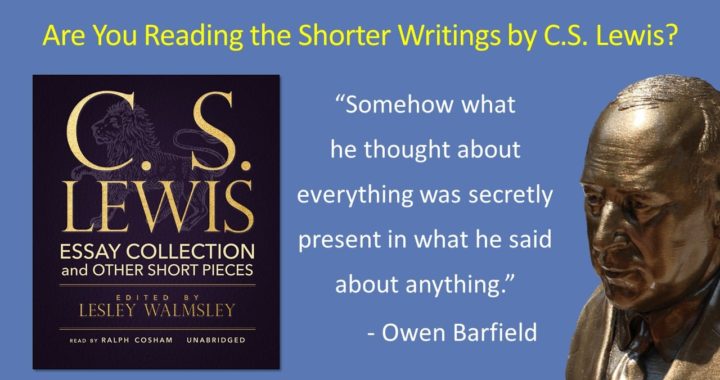What he [C.S. Lewis] thought about everything was secretly present in what he said about anything.
Owen Barfield
If you are a serious student of the ideas of C.S. Lewis, there are two primary ways to “go deep” on his meaning. First, you read, re-read, and then read again all of Lewis’ major books. With every iteration new insight will open to you. If you read even just a few of the major books by C.S. Lewis, you will begin to appreciate just how percipient his friend Owen Barfield was about this.
The second way to “go deep” on his meaning is to supplement the reading of his books with extensive reading of his shorter works. What Barfield noticed becomes increasingly evident as your reading expands to include Lewis’ essays and sermons.
Sadly, I suspect many Lewis readers never make it beyond Mere Christianity, The Screwtape Letters and The Chronicles of Narnia. If you are not yet reading the shorter works of C.S. Lewis, I contend that you should be. Why is that? First and foremost, because some of his most cogent reasoning and most elegant prose is to be found in his essays and sermons. Second, he addressed so many more topics, often in greater depth, in these 200+ pieces.
While Owen Barfield was commenting on C.S. Lewis’ “presence of mind,” he seemed to say Lewis’ body of work is “organic”. This means not only that his ideas are consistent across all his writings, but also that these writings are mutually reinforcing. How do I mean?
Several weeks ago, I was teaching a seminar on “The Weight of Glory” for a Men’s group in Atlanta. By chance, I was at the same time re-reading The Problem of Pain. These are my two favorite works by C.S. Lewis. Even though I have read each of them 30 or more times, I never really noticed how closely what Lewis said in the great sermon delivered to an SRO audience in June of 1941 tracks with what Lewis wrote in Chapter 11 (“Heaven”) of The Problem of Pain, a book published only six months earlier. It was the juxta-positioning in time that enabled me to discern more fully the parallels.
I have read most of Lewis’ books and have come to know the truth of Barfield’s observation–so many times. As much as I have perceived Lewis’ remarkable consistency of thought across his 30+ books, I believe Barfield’s premise is equally relevant as one explores Lewis’ shorter writings.
In my experience, I have learned that I can better triangulate on Lewis’ often challenging ideas when I source content from a wide range of his works–not just his books, but his essays and sermons, and even his 20,000+ letters. To whatever extent I am blessed to grasp the brilliance of Lewis’ thinking, I am quite sure my understanding has been augmented by reading his shorter works.
My Purpose
Frequently on Facebook, Lewis group members ask: “What are your favorite books by C.S. Lewis?” The ensuing discussions are interesting, perhaps even useful. However, I do not recall ever seeing a post that asks: “What are your favorite C.S. Lewis essays?” Until now.
By asking this question, and posting the results, I hope to accomplish the following objectives:
- To promote wider reading of some of C.S. Lewis most illuminating and inspiring works.
- To provide guidance to those who wish to explore Lewis’ shorter works, but who are not quite sure where to start.
- To make informed recommendations on which collections of shorter writings would be most useful for readers to purchase.
I will follow this post with three more posts on the matter over the next few days.
Part 1 | Part 2 | Part 3 | Part 4 | Part 5
Next up: Part 2 – Survey Process and Participants
